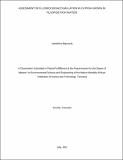| dc.description.abstract | Fluoride bioaccumulation in fish poses a significant impact to their growth performance,
survival and consequently to the upper trophic levels. Few studies have reported the impact of
high fluoride concentration and their accumulation to catfish in African settings. A 60-days
African catfish (Claris gariepinus) cultivation was conducted at Ngarenanyuki ward and at the
Nelson Mandela African Institution of Science and Technology (NM-AIST) laboratory in
Arusha, Tanzania, to determine fluoride bioaccumulation and its effect on growth and survival
of the catfish. The juvenile catfishes were exposed to water containing 36 mg Fˉ/L in a fishpond
and synthetic water containing fluoride concentrations (NaF) of 5, 15, 36 and 45 mg/L in the
aquaria set at NM-AIST laboratory. Fish growth and survival was determined and the fluoride
concentrations in fish tissues were analysed by ion selective electrode. At the end of the
experiment, fish survival rate was greater than 90% in fluoride levels of 5, 15, 36 mg/L
compared to 65.8% in 45 mg/L aquaria treatment. Also, significant fluoride bioaccumulation
was observed in fish bones (222.00 mg/kg, dry weight) followed by gills (177.4 mg/kg), skin (9
mg/kg) and low amount in fillets (1.467 mg/kg). In all these tissues, fluoride bioaccumulation
significantly rose with increase in fluoride levels in the water and exposure time (p< 0.001).
From this experiment, it is concluded that high fluoride occurrence in surface water led to
increased bioaccumulation in the African catfish and correlates with exposure time. Therefore,
to grow catfish in water containing more than 45 mg/L requires a deflouridation process to take
place. | en_US |


